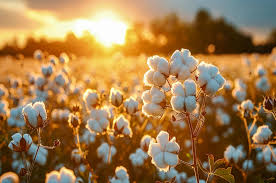Cotton Market : Key Drivers, Regional Insights & Forecast to 2033
Global Cotton Market Size and Share Analysis – Growth Trends and Forecast Report 2025–2033 Market Overview The global cotton market...

Global Cotton Market Size and Share Analysis – Growth Trends and Forecast Report 2025–2033
Market Overview
The global cotton market was valued at USD 43.00 billion in 2024 and is projected to reach USD 55.57 billion by 2033, growing at a CAGR of 2.89% during the forecast period. Cotton continues to be a cornerstone of the textile industry, supported by its natural attributes, rising demand across apparel and industrial applications, technological progress in agriculture, and government subsidies in major cotton-producing nations.
1. Introduction to Cotton Market
Cotton, a natural cellulose fiber from the Gossypium genus, is a key raw material in the global textile and apparel industry. Known for its breathability, softness, and sustainability, cotton plays a critical role across industries—ranging from clothing and household fabrics to medical supplies and industrial applications. Its widespread cultivation across continents like Asia, North America, and South America reinforces its status as a global commodity.
2. Global Cotton Market Dynamics
2.1 Growth Drivers
a. Surge in Demand from Textile and Apparel Industry
The fashion and clothing sectors are the largest consumers of cotton, particularly in countries like China, India, Bangladesh, and Vietnam. Cotton’s natural texture and affordability make it a preferred choice in both fast fashion and premium segments. The shift toward sustainable natural fibers is further boosting cotton’s appeal in both developed and emerging markets.
b. Government Subsidies and Strategic Support
Countries such as the United States, China, and India provide strong support for cotton growers through minimum support prices, irrigation schemes, and R&D. These initiatives help stabilize income for farmers and enhance global cotton competitiveness. For instance, the USDA invested $50 million in May 2022 to support the worsted wool and Pima cotton industries post-COVID-19 disruptions.
c. Technological Advancements in Agriculture
From genetically modified (GM) seeds to precision irrigation and mobile-based decision-making tools, innovations are enabling higher cotton yields and reducing environmental impacts. Countries like India and the U.S. are witnessing rapid adoption of smart farming practices. In April 2024, India launched a Cotton Technology Mission to improve productivity and quality standards.
2.2 Key Challenges
a. Climate Change and Water Scarcity
Cotton’s water-intensive nature and vulnerability to climate variability pose serious risks. Regions like Pakistan and parts of India face challenges such as erratic monsoons and increasing droughts, which raise production costs and threaten long-term sustainability.
b. Price Volatility and Trade Barriers
Global cotton prices are impacted by geopolitical tensions, export/import regulations, tariffs, and currency fluctuations. Trade disruptions, such as those between the U.S. and China, have caused uncertainty in export volumes and profitability, affecting global supply chains.
Related Report
Netherlands Organic Fertilizer Market
Denmark Organic Fertilizer Market
3. Global Cotton Market Segmentation
3.1 Production Analysis
Major producers—India, China, the U.S., Brazil, and Pakistan—have robust infrastructures and diverse agro-climatic advantages. While India leads in cultivation area, the United States dominates yield efficiency through biotech and mechanized farming. For instance, Upland cotton accounted for 99% of U.S. production in 2023, with Texas contributing nearly 40%.
3.2 Consumption Insights
Asia dominates global cotton consumption due to its strong textile base. Countries such as China, India, Vietnam, and Bangladesh rely heavily on cotton to meet garment export demands. As fashion trends shift toward eco-conscious products, consumption of organic and recycled cotton is rising globally.
3.3 Import Trends
Countries with textile-heavy industries but limited domestic cotton output—like China, Vietnam, Bangladesh, and Turkey—lead global imports. In 2023, China alone imported 27.2% of the world’s cotton. Import decisions are increasingly influenced by supply chain resilience, trade deals, and price parity.
3.4 Export Trends
The United States, Brazil, and Australia are leading exporters, supplying high-quality cotton globally. U.S. cotton, favored for its quality, is exported primarily to China, Pakistan, and Vietnam, which made up 52% of its export volume in 2023. Export performance is shaped by global demand, exchange rates, and regional production trends.
4. Regional Insights
United States
A top cotton producer and exporter, the U.S. leverages advanced biotechnology, R&D, and favorable agro-policies. Cotton is mainly grown in Texas, Georgia, and Mississippi. Exports rose by 4.05% in January 2023, reaching USD 1.89 billion. Despite trade tensions, the U.S. remains a global cotton benchmark.
United Kingdom
Although the UK does not cultivate cotton, it imports significantly for its textile industry. There’s rising interest in ethically sourced and organic cotton, influenced by sustainability initiatives. Asia and Africa are major suppliers to the UK, especially post-Brexit.
Germany
Germany is a leading consumer and processor of cotton-based products, especially in fashion and automotive textiles. With a mature textile machinery industry, Germany emphasizes traceability and sustainability. In July 2024, TURNS GmbH partnered with Tailorlux to enhance transparency in recycled cotton product supply chains.
5. Competitive Landscape and Strategic Initiatives
Leading companies are integrating across the cotton value chain, adopting technologies to improve traceability and efficiency. Key players include:
- RSWM Limited, which acquired Ginni Filaments in Dec 2023 to diversify its premium cotton offerings.
- LVI, acquired by GALLS in Feb 2024, aims to strengthen military and performance textile logistics.
- TURNS GmbH and Tailorlux GmbH, working to pioneer fiber-level transparency in European markets.
6. Market Outlook and Future Trends (2025–2033)
Key Future Trends:
- Adoption of Organic & Sustainable Cotton: Brands will invest more in traceable and eco-certified cotton.
- Technological Transformation in Cultivation: More GM seeds, drip irrigation, AI-based crop monitoring.
- Regional Expansion in Processing: Africa and Southeast Asia may emerge as new hubs.
- Circular Economy Practices: Focus on cotton recycling and reuse in line with global ESG goals.
Strategic Recommendations:
- Governments should incentivize water-efficient cotton farming.
- Manufacturers must invest in supply chain transparency and sustainability.
- Policymakers need to align trade agreements with long-term cotton import-export goals.
7. Frequently Asked Questions (FAQs)
- What is the projected size of the global cotton market by 2033?
USD 55.57 billion. - Which country leads in cotton production by area?
India. - What is the major driver of cotton consumption?
Textile and apparel industry demand. - Who are the top exporters of cotton?
U.S., Brazil, and Australia. - Which countries dominate cotton imports?
China, Vietnam, Bangladesh, and Turkey. - What are the main challenges for the global cotton market?
Climate change, water scarcity, and trade volatility. - How is technology impacting cotton farming?
Through GM seeds, precision agriculture, and digital tools. - Is sustainability influencing cotton demand?
Yes, there is a strong shift toward organic and traceable cotton. - What role does the U.S. play in the global cotton market?
A top producer, exporter, and innovator in cotton farming. - Are cotton prices stable globally?
No, they are influenced by trade policies, weather, and demand cycles.







